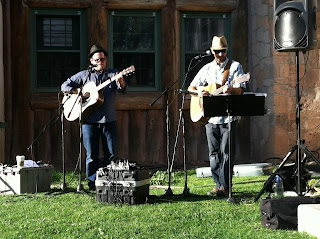Tools & Materials: seam ripper, thread that matches the shirt you plan to alter, stitch glue (or superglue), iron/ironing board, sewing machine and/or serger, small scissors. If you just have access to a serger, you can finish by hand, but you'll also need a needle for hand-stitching.
Safety disclaimer: keep your fingers out of the works. It's going to sound pretty un-manly but a sewing machine is a power tool, too. I watched my mom sew her finger once with a sewing machine. When it happened, she jerked back and broke the needle off in (through!) her finger. Not pretty. Dad got it out with a pair of needle-nose pliers while mom puked in the sink. A serger has a blade that cuts while it stitches. Watch out for that, too.
Here's a little shirt anatomy:
Step 2: button the shirt and turn it inside-out.
Step 3: find a shirt you like that fits you well. Button it and turn it inside out.
Step 4: put the shirt that fits you on top of the shirt you want to alter. Line up the shoulders and centers of the shirts. The armpits should line up as well if they are similar size.
Step 5: transfer the shape of the shirt that fits you onto the one that doesn't using some kind of marker, leaving yourself a little extra room (1/8" or so) for mistakes. I use a Sharpie because I can actually see the bold line, and I figure that I'm going to cut off the marker line anyway, so it won't bleed in the wash and stain my shirt. You can faintly make out the dotted line in the picture below. With a dark shirt, fabric pencil or chalk will probably work better. Pin on your line to hold the shirt where you want it. Both layers of fabric (the front and back of the shirt) should lie flat.
Step 6: sew on/just inside your line. If you are using a serger, the machine will cut the fabric as you sew and "overlock" the seam, leaving a finished edge that won't fray. Pretty awesome. Fray check or superglue the ends of the overlocked seam.
Step 8: turn your altered shirt right side-out and double-check your seam. Sometimes the thread color from the serger will show through (I usually use whatever color is on the serger as 1) I'm cheap so I don't have a full pallette of serger thread colors, and 2) the threads (4 of them!) are a pain to change). In that case, turn the shirt back inside-out and, using your regular sewing machine with the thread that matches your shirt, stitch right on the serger stitch close to the shirt body. Turn right side-out and triple-check the seam.
Step 9: try on your shirt. Congratulations, it fits much better! I might wear this one on Friday for the Los Alamos Concert Series concert featuring D.K. & THE AFFORDABLES!











